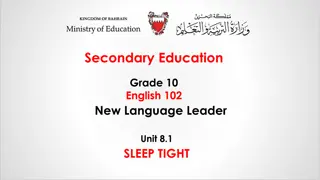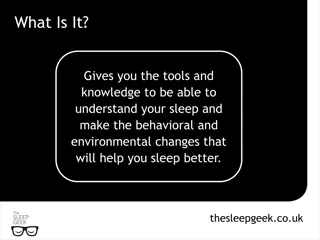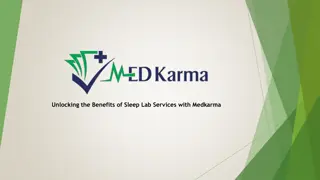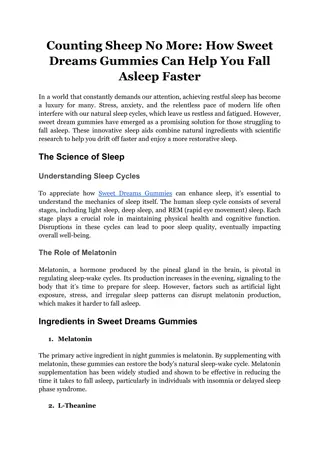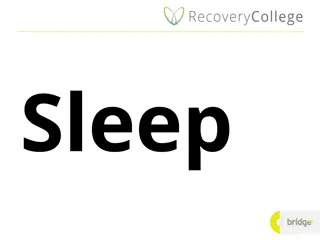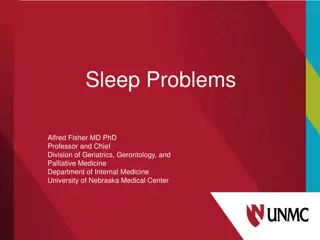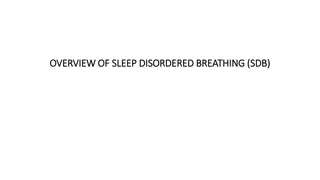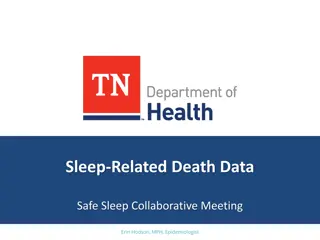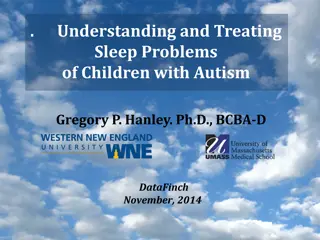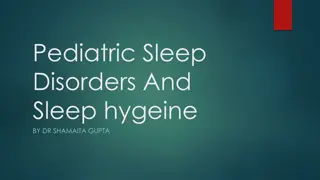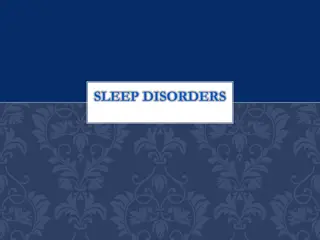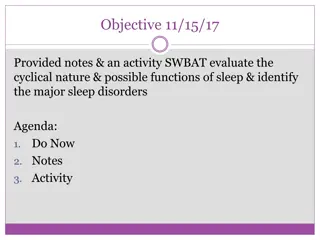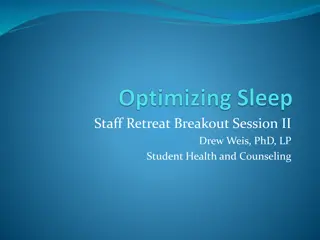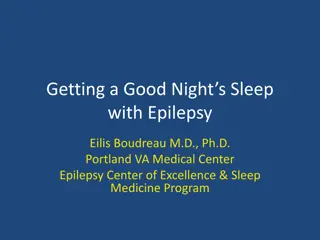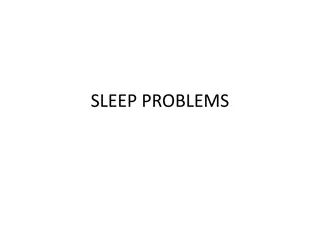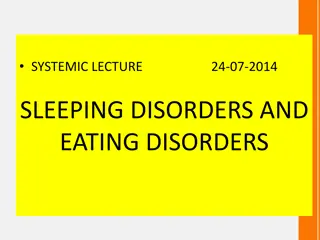Understanding Children's Sleep Patterns and Overcoming Sleep Problems
Exploring the importance of good sleep in children, this informative content delves into normal sleep patterns, issues related to sleep-disordered breathing, and strategies for referral and treatment of sleep problems. It discusses the nature of sleep, when it begins in humans, the rapid changes in newborn sleep, and addresses common questions parents have about their baby's sleep. With valuable insights from a pediatric pulmonologist, Dr. William Wooten III, this resource sheds light on essential aspects of children's sleep health.
Download Presentation

Please find below an Image/Link to download the presentation.
The content on the website is provided AS IS for your information and personal use only. It may not be sold, licensed, or shared on other websites without obtaining consent from the author. Download presentation by click this link. If you encounter any issues during the download, it is possible that the publisher has removed the file from their server.
E N D
Presentation Transcript
A Good Nights Sleep is Important ! Overcoming Sleep Problems in Children William Wooten, III, MD Pediatric Pulmonology and Sleep Medicine Brody School of Medicine, ECU
Sleep in Children Questions to be Answered What constitutes normal sleep in children? What are features of sleep-disordered breathing in children? Referral and treatment for sleep problems who, where, and what?
What is Sleep Anyway? A naturally recurring state characterized by altered consciousness with relatively inhibited sensory and motor activity.
When does sleep begin? Human sleep begins during embryonic development Cycles of brain activity at 8- 10 weeks gestation REM sleep develops around 28-32 weeks
Newborn Sleep Changes Rapidly ACTIVE SLEEP (REM) QUIET SLEEP (NON-REM)
Question Parents of a 2 month old boy complain that he is not yet sleeping through the night from midnight to 5 am. What is the correct response?
Question Parents of a 2 month old boy complain that he is not yet sleeping through the night from midnight to 5 am. What is the correct response? Reassurance - Most babies sleep through the night by 6-9 months of age.
Question Parents of a 2 month old boy complain that he is not yet sleeping through the night from midnight to 5 am. What is the correct response? Reassurance - Most babies sleep through the night by 6-9 months of age. Sleep through the night defined as 5 hours of uninterrupted sleep
Newborn Sleep Sleep onset REM (like narcolepsy) until 6 months and indeterminate sleep on EEG Sleep/wake cycle every 4 hours 80% of time spent sleeping Circadian rhythm matures around 3-6 months of life
3-4 hr autonomous rhythm 3 months 4 months Circadian rhythmicity develops around 3-4 months of age Synchronized sleep pattern
Sleeping Through the Night Sleep Training Methods Parent resources: sleep training Solve Your Child s Sleep Problems (Ferber) Healthy Sleep Habits, Healthy Child (Weissbluth) On Becoming Babywise (Ezzo and Bucknam)
Ferber method Progressive waiting method Teach baby to soothe himself when physically ready (at least 3-5 months) Put baby in bed awake, leave for gradually longer periods of time Allows infant to develop sleep associations
Weissbluth method Extinction method Parents watch for sleep cues (ie yawn, rubbing eyes) Soothe before putting in bed Extinction: cry it out indefinitely, up to an hour for naps Earlier bedtime if sleep issues (to prevent over-tired child)
Babywise method Feed infant on a strict 3-4 hour schedule from birth regardless of demand Baby should sleep through night from 8-12 weeks AAP issued a statement that this method is dangerous and should not be followed
Recommended Sleep Times: National Sleep Foundation 2015 Newborns (0-3 months): 14-17 hours each day (previously it was 12-18) Infants (4-11 months): 12-15 hours (previously it was 14- 15) Toddlers (1-2 years): 11-14 hours (previously it was 12-14) Preschoolers (3-5): 10-13 hours (previously it was 11-13) School age children (6-13): 9-11 hours (previously it was 10-11) Teenagers (14-17): 8-10 hours (previously it was 8.5-9.5) Younger adults (18-25): 7-9 hours (new age category) Adults (26-64): 7-9 hours (no change) Older adults (65+): Sleep range is 7-8 hours (new age category)
Naps what is normal? 3 naps by age 3 months 2 naps by age 6-9 months 1 nap by age 12-15 months 0 naps by age 4-5 years
Infant Sleep Problems Parents of a 15 month old girl report that she awakens multiple times at night. With awakenings, mother picks her up, rocks her, and feeds her from a bottle until she falls asleep. What is the diagnosis?
Infant Sleep Problems Parents of a 15 month old girl report that she awakens multiple times at night. With awakenings, mother picks her up, rocks her, and feeds her from a bottle until she falls asleep. What is the diagnosis? Diagnosis: Behavioral Insomnia of Childhood: Sleep Association Disorder
Behavioral Insomnia of Childhood Sleep association disorder 6-36 months Delayed sleep onset and awakenings Sleep onset becomes related to external cues Parent rocking child to sleep, drinking from a bottle Sleep will not occur without cues
Behavioral Insomnia of Childhood Limit setting sleep disorder >18 months Delayed bedtime; otherwise normal sleep Parents unable to control behaviors around bedtime or awakenings Usually inadvertently reinforce bad behaviors Inconsistent limit-setting
Behavioral Insomnia: Tips for Parents Focus on bedtime routine Be consistent and predictable Good: Play with toys, read books, take bath Bad: TV, electronics, snacking after dinner Maintain regular bedtime (not too late)
Behavioral Insomnia: Tips for Parents Focus on environment Keep things quiet Dim lights Maintain a restful sleeping space Avoid games or activities in bed Remove distractions
Behavioral Insomnia: Tips for Parents Establish sleep associations Toy/object to crib with child, not available during the day Don t become a sleep association try to be boring or robot parent after bedtime
Behavioral Insomnia: Tips for Parents Remember to reward good behavior !
Get Rid of Bad Sleep Associations! No bottles in the crib ! Can lead to cavities, GERD, aspiration
Get Rid of Bad Sleep Associations! baby's sleeping
Remember to think about Caffeine Starbucks sippy cup
Question Parents of a 3 year old girl are concerned about awakenings at night when she sits up, mumbles a few words and then goes back to sleep. This has been happening almost every night for the past few months and she does not seem to remember the events. What would be appropriate to do next?
Question Parents of a 3 year old girl are concerned about awakenings at night when she sits up, mumbles a few words and then goes back to sleep. This has been happening almost every night for the past few months and she does not seem to remember the events. What would be appropriate to do next? Ask about symptoms of sleep disorders,
Question Parents of a 3 year old girl are concerned about awakenings at night when she sits up, mumbles a few words and then goes back to sleep. This has been happening almost every night for the past few months and she does not seem to remember the events. What would be appropriate to do next? Ask about symptoms of sleep disorders, Ensure safety of sleep environment,
Question Parents of a 3 year old girl are concerned about awakenings at night when she sits up, mumbles a few words and then goes back to sleep. This has been happening almost every night for the past few months and she does not seem to remember the events. What would be appropriate to do next? Ask about symptoms of sleep disorders then, Reassurance Ensure safety of sleep environment
Parasomnias Normal or Not? Parasomnias are usually normal in children If frequent, may indicate condition causing arousal OSA Restless legs syndrome Seizures can be confused with parasomnia
Parasomnias Parasomnias: Disorders of Arousal Non-REM parasomnias Confusional arousals Night terrors Sleepwalking Sleep-related eating disorder REM parasomnias Nightmares REM behavior disorder
Disorders of Arousal Occur in NREM ,usually deep sleep (early night) Patient remains asleep during / following arousal No recollection of event Classic types: Confusional arousals Night terrors Sleepwalking
REM parasomnias Nightmares Occur during REM Usually occur LATE at night (early morning) Recollection of dream REM behavior disorder Absence of normal REM atonia Large movements and/or complex behaviors Acting out dreams with recollection of dream when awakened Associated with neurodevelopmental disorders and medications
Nightmares or Night Terrors? Nightmares Most often occurs late night/ early morning hours (REM sleep) Awakenings from sleep with frightening dreams Child responds to being consoled Night terrors Usually occurs in the early night (non-REM) Awakenings from sleep with crying, screaming Child does not respond to being consoled Will not remember in the morning
Nightmares and Fears: Tips Read happy books at bedtime, avoid scary videos Bedtime ritual should be quiet, comforting Physical reassurance is helpful Be careful about monster hunts and monster sprays Child sleeping in your bed May work temporarily Often becomes a habit
Question Parents of a 5 year old girl complain of heavy snoring every night. Parents have witnessed respiratory pauses during sleep. Tonsils are enlarged. She has symptoms of ADHD and is on stimulant medications. What is the suspected diagnosis?
Question Parents of a 5 year old girl complain of heavy snoring every night. Parents have witnessed respiratory pauses during sleep. Tonsils are enlarged. She has symptoms of ADHD and is on stimulant medications. What is the suspected diagnosis? Obstructive sleep apnea What next?
Overview of SDB - Questions What is sleep disordered breathing?? Why is it important (and different) in children? What common conditions are associated with sleep disordered breathing during childhood? How to reconcile different evaluation/treatment guidelines for OSA in children (AASM, AAP, AAOHNSF)? What are new and emerging treatments for sleep apnea in children?
What is SDB ? Sleep-disordered breathing Nonspecific, umbrella term encompassing spectrum of respiratory alterations during sleep Often refers to airway obstruction during sleep Primary snoring (PS) Upper airway resistance syndrome (UARS) Obstructive sleep apnea syndrome (OSAS) Also encompasses sleep related hypoventilation syndromes and central sleep apnea
Spectrum of SDB in Children Obstructive sleep apnea syndrome (OSAS) Obstructive events, arousals and gas-exchange abnormalities (O2, CO2) Upper airway resistance syndrome (UARS) Flow limitation, arousals, criteria not met for hypopneas Primary snoring - snoring NOT associated with gas exchange abnormalities or arousals.
OSA in Children is Important Obstructive sleep apnea (OSA): Repeated events of partial or complete upper airway obstruction during sleep. Diagnosed by polysomnography (PSG). Upper airway obstruction causes disruption of ventilation and/or sleep structure (sleep fragmentation) Implications for developing nervous system: neurobehavioral and cognitive problems (ADHD, learning problems)
Pediatric OSA: Research Topic Pediatric Obstructive Sleep Apnea on PubMed per year
Adenoid facies http://radiopaedia.org
2 Peaks of OSA prevalence Peak 1: Adenotonsillar hypertrophy (3-6 yr) Peak 2: Obesity (adolescents) 0 3 6 9 12 15 18
Symptoms of SDB in Children NIGHT symptoms Snoring, apnea, restlessness, night sweats Awakenings may precipitate disorders of arousal (night terrors, confusional arousals, sleepwalking) Nocturnal enuresis Children who snore and wet the bed are more likely to have moderate to severe sleep apnea than those who stay dry at night (Pediatric Research 2014)
Symptoms of SDB in Children DAYTIME symptoms Neurocognitive impairment (poor school performance) Behavior problems (aggression, irritability) Cardiovascular morbidity Changes in appetite, weight
Exam: SDB in children Adenoid facies High-arched palate Narrow nasal passages Short upper lip Crowded, prominent teeth Small maxilla Adenoid facies Mouth breathing leads to molding of facial bones http://radiopaedia.org


